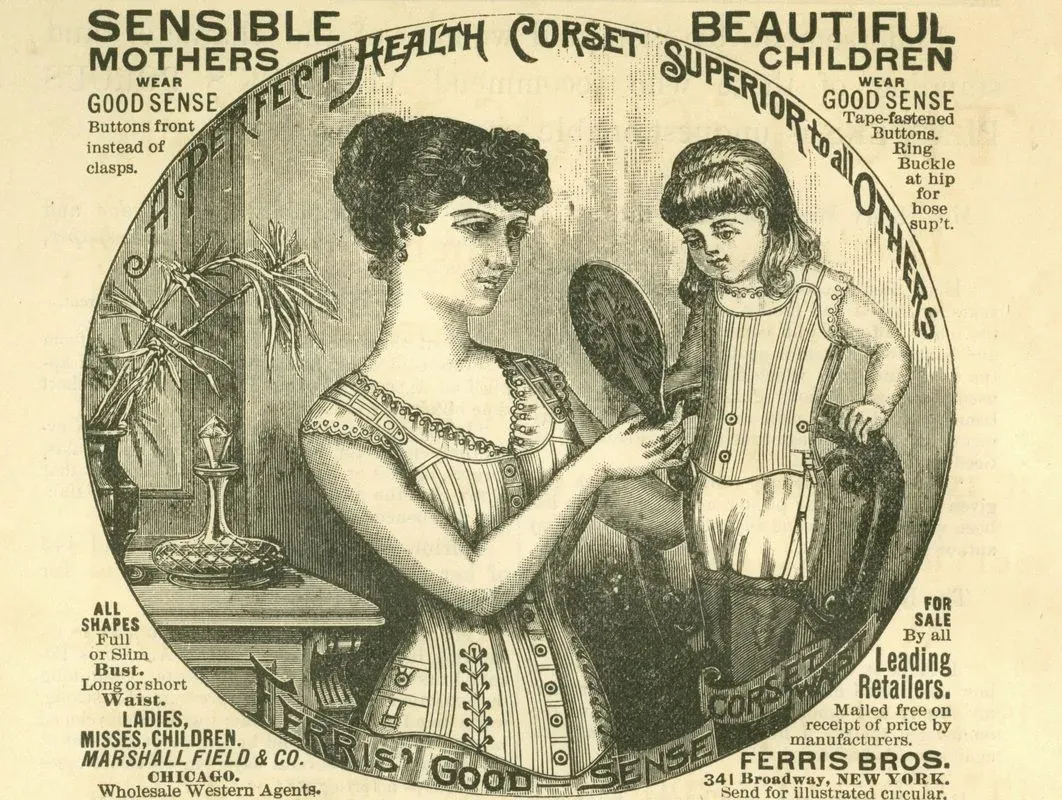I wore lingerie for the first time in years. It was a disaster
Lingerie is complicated because lingerie is not neutral. It is a consumer good driven by exclusionary trends.

A pandemic with both Riley and me working from home has magnified some aspects of our marriage. Every day we wake up with the same person, every day is the same. Riley and I eat every single meal together right now. Monotonous monogamy. I kind of love it. But I know it’s not sustainable. One snowy day, I thought it was time to disrupt this ongoing sameness with something fun. Like, I don’t know. A night of lingerie-fueled lust. Usually, I’d order something online but deciding you want to wear lingerie is kind of like deciding you want to get bangs - if you wait too long, the feeling might pass.
I put on my mask and drove to a nearby only adult store. A fluorescent lit affair with a deal on thongs, five pairs for $25. It was kind of like Walmart but with sex toys. The masked woman working behind the plexiglass protected cashwrap was helpful. She pointed to the vibrators, “I like that one for partner play and this one for personal play.” She didn’t laugh when I nervously quipped, “Ah, the Quadruple Ps”.
None of the lingerie hanging on racks was appealing, lots of straps and zippers. But there was a display of lingerie in little black boxes. Like a hosiery display at Target! That felt familiar! Instead of pictures of tight-clad legs, each box had a buxom woman in a sheer bodysuit or stocking. The box said each design fit sizes 2 - 14. The salesperson assured me this was true. I fall in that range. I picked a minidress with off the shoulder sleeves and a hem that hit just below the bum. It was also pricked with strategically placed holes. I purchased it with some degree of confidence.
The confidence was misplaced.
That night, I joked with Riley that I was going to “slip into something a little more comfortable” and then went into the bathroom. Took off my jeans and sweater, opened the box and held up the dress, incredulous. It looked like it was made for an American Girl Doll. Like, an upsetting American Girl doll. But still! It was tiny. I peered into the box, half-expecting to see other tiny accessories to go with it. A doll-sized whip and pair of doll stiletto heels, maybe. No matter. The woman at the store assured me it stretched. At this point, I still believed her.
I pulled it on over my head and worked it down my body. This was such a strenuous process, I had to pause for breath. Looking down at myself, I felt some…hesitation. Our bathroom does not have a full length mirror. There’s just a little framed mirror perched above a small sink. I pulled it off the wall and held it away from myself, taking my body in by halves and tilted angles. The garment flattened and bulged at the same time. Not ideal. Setting the mirror down, I pulled the dress up, down, then up again and to the side. Holding up the mirror again, I checked pieces of my reflection between each adjustment. Sometimes the garment shifted from bad to worse and then back again but it never really got better. At one point one entire nipple popped out of one of those not-so-strategically placed holes. It was like the Eye of Sauron. Unsettling.
I’d been in the bathroom for fifteen minutes. Riley was going to begin to worry. (I have a history of falling down.) In the beginning of our marriage, I would have gone out in that piece of nightmare lingerie. Tugging at the hem, embarrassed and earnest. That night, I put my jeans and sweater back on and went out to Riley, slightly more disheveled than the last time he saw me. He was confused. And then delighted. When I told him the story he laughed and laughed and I did too. It takes a measure of safety to have that interaction. It took us a few years of marriage to get to that safe place. After the laughter, and maybe because of it, we went on to have great ummmm partner play.
The abominable doll dress is shoved somewhere in our closet.
Women’s underwear in western culture wasn’t always this complicated. It started out pretty simple. Everyone wore “t-shaped undergarment (which later became the t-shirt) which both sexes donned to refrain from having to bathe too often or rendering their clothing too malodorous.” Then a few queens decided to start embellishing their undergarments with embroidery. Others in the court followed suit. The embroidery was meant to be seen, by a select few. After the embroidery came more complicated tailoring, pinning and corseting.
Undergarments went from a soft defense against unpleasant smells to hard tools of seduction. Initially, corsets were more concerned with flattening the bust than tightening the waist. By the 1700s, some corsets tied tightly in the back, forcing the shoulders back and the breasts up and out. Sometimes corsets were so restrictive, they cracked ribs and harmed soft tissue - skin, muscle and organs. One of my ancestors wrote about experiencing bruising and stress fractures from her corsets.
This wasn't a universal experience. Many of our foremothers liked wearing corsets the same way many women like wearing them now. The debate around whether corsets shaped or supported, liberated or oppressed have been around as long as corsets. Loved or not, the garment did tend to restrict movement and dictate shape. In the Victorian era, the rational dress reform movement began. The movement made the radical claim that women’s clothing shouldn’t harm them. (A claim we agree with while wearing stiletto heels that often cause muscle shortening in our legs and hairline fractures in our feet.) In the years that followed the dress reform, we’ve had: bloomers, body stockings, garters, girdles, slips, g-strings, teddies, tap pants, nighties, negligees, waspies and body chains. And it’s all kind of…complicated.
Why?
Lingerie is complicated because lingerie is not neutral. It’s not just silk or polyester dress up, or rather, dress less. It is a consumer good driven by exclusionary trends. Those trends are dictated by the shifting definitions of what parts of a woman society deems most desirable. Sometimes breasts, sometimes hips, sometimes the bum, sometimes covered, sometimes uncovered - never all at once. The narrow and always shifting definition of the desirable woman doesn’t apply to most women. Any definition of women that excludes women is a bad definition. These definitions have also been historically (and presently) ableist, racist and generally misogynistic. Women are often rightfully wary of lingerie. When they bring it into their homes and onto their bodies, they are submitting to a definition of beauty that excludes them.
The prevailing idea that lingerie exists to magnify a woman’s desirability is one I’d like to see more of us contend with openly. I would like my partner to desire me but I refuse to be burdened with being desirable. This is a fine but important distinction. When I put on lingerie it is much less about making me seem desirable and much more about signalling my intention. Wearing lingerie should be an act of ownership, of my body, my sexuality and the intimacy I am about to engage in. How can I feel that ownership when wearing a piece of clothing made to look good exclusively on a woman with longer legs, a smaller bum and bigger breasts? A loss of security always attends a loss of ownership. Sex without security strips many women of positive outcomes like, ahem, orgasms and real intimacy.
I wore lingerie pretty routinely during my twenties. I thought that’s what sex positive people did. I also spent those years working to disentangle myself from American body-shaming culture. That work, mostly, worked. It was difficult and messy but I reached a point where I truly delighted in how I looked naked. When I did, I tossed my increasingly ignored stash of ill-fitting lingerie. Chantal Thomass, a French lingerie designer said, "The essence and attitude of lingerie is all in suggestion.” She was talking about what it suggests to the observer but what lingerie says to the wearer matters too. I didn’t like what lingerie was suggesting tome. I didn’t need it to keep suggesting I should squeeze, inject or starve myself into an unnatural shape. That funny bathroom doll dress fiasco was the first time I’d put on lingerie in years.
I recently took a poll about lingerie on my Instagram. The poll had about three thousand respondents. This is not scientific! I’m not going to submit it to the NYT anytime soon. But it is illustrative. According to my poll, a majority of women hadn’t worn lingerie in the past year. Many of them felt objectified by it or ashamed of how it made them feel. Most women reported liking sex even if they hated lingerie. A majority of women who do not wear lingerie now, would shop for lingerie if they could find more inclusive brands. Inclusive sizing, representation, and materials. And many, both partnered and single, reported that the isolation of the pandemic made them interested in dabbling in the world of lace and (g)string.
They’re not alone! According to Vogue (a publication with it’s own long history of exclusion), “stores [are] reporting increased interest in both sexy and comfortable intimates and loungewear.” That increased interest means money for the industry. By 2025 it will be worth $11.3 billion. As the industry expands, more inclusive brands are being born. In 2018, Rihanna debuted Savage x Fenty, a lingerie brand that’s made representation a core part of its mission.
When I go to La Perla online, I’m met with a grid of photos of thin white legs and waists. A visit to Savage x Fenty and my screen fills with color. Some of the models look like me, others do not. Rihanna’s brand celebrates the spectrum of beauty inhabited by all people. Brooklyn White writes, “Blackness, queerness, womanhood, othering, and their intersections, are not hindrances in Rihanna’s world, but rather facets to be proud of.” Lingerie should know no bounds. (Unless you WANT it to include bindings. In which case, pursue your happiness, my friends.)
I bought some lingerie from Savage x Fenty after the boxed lingerie debacle. A few pieces are for me to wear whether my partner will see me or not. Pretty underwear isn’t always about sex. And a few pieces sit ready for me to put on when I want to ummmm signal my intentions. A favorite is a laced purple bodysuit. When I put it on, I didn’t feel like an object. I just felt like me. My stretch marks and the lace complemented one another. A slick of lipstick and something had been reclaimed. It wasn’t my desirability or my sexuality. It was instead, a right to adorn myself how I want, if and when I want, for who I want.
And I don’t know, that felt pretty damn sexy to me.
A few favorite inclusive lingerie brands. None of them are affiliate links!
and of course Savage x Fenty, this is is my favorite piece from them so far.
Lingerie is just one of many things that can be incorporated into a healthy sex life. You can take it or leave it! Sex can be fun but it can also be hard. Many of us have so much to unpack from our upbringing, past trauma and a culture that views us as objects. Have you followed Kristin Hodson? She’s a really approachable sex therapist. I recommend engaging with her as you navigate your own sexual journey or help your kids navigate theirs! I can’t tell how how much I’ve learned from her about sex positive me and sex positive parenting.



